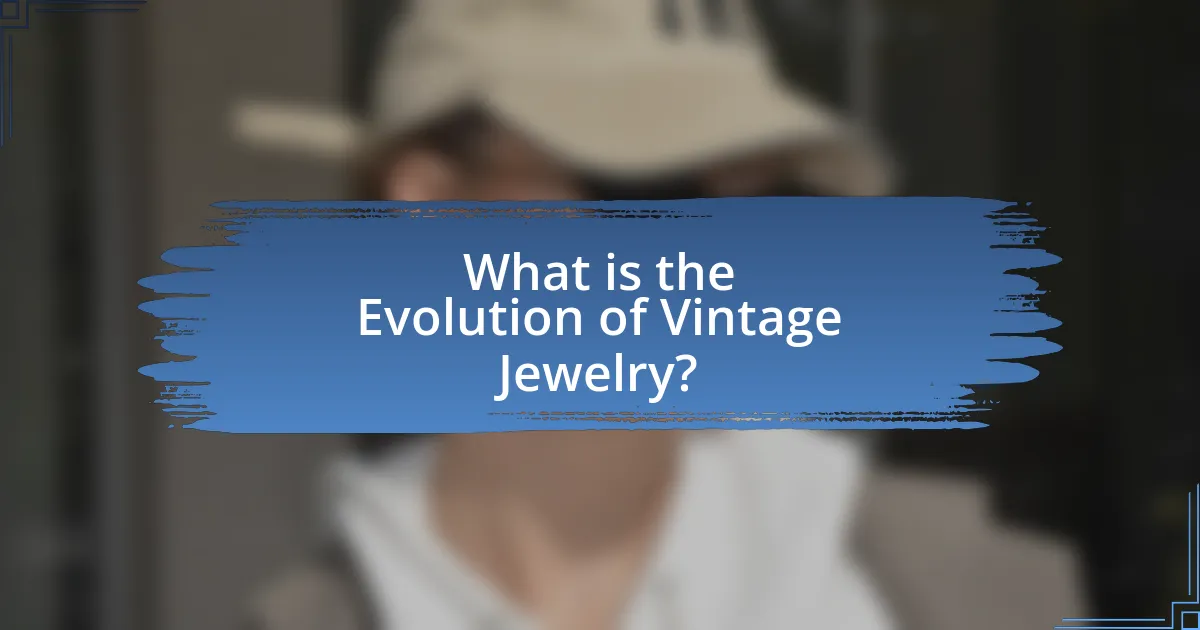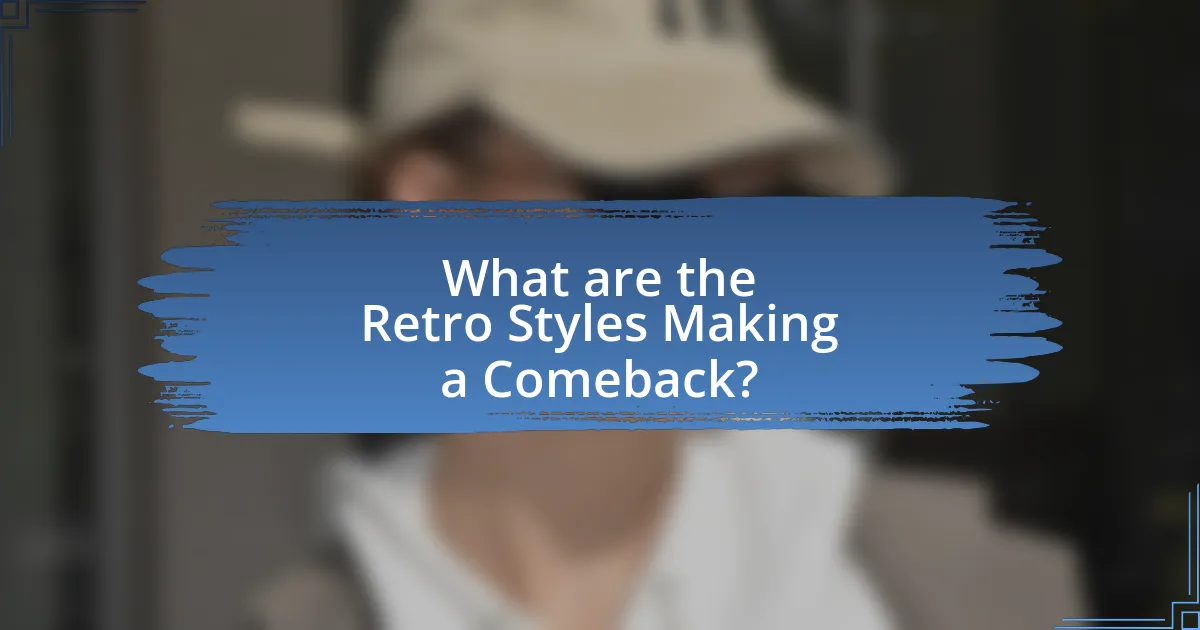The article explores the evolution of vintage jewelry, highlighting its historical significance and the impact of cultural influences on design trends. It details key styles from various decades, such as the intricate motifs of the Victorian era, the geometric shapes of Art Deco, and the eclectic designs of the 1970s. The resurgence of vintage jewelry in contemporary fashion is attributed to a growing appreciation for craftsmanship, sustainability, and personal expression. Additionally, the article discusses how nostalgia and emotional connections enhance the appeal of vintage pieces, while providing practical tips for incorporating them into modern wardrobes and caring for them effectively.

What is the Evolution of Vintage Jewelry?
The evolution of vintage jewelry reflects changing fashion trends and cultural influences over time. Initially, vintage jewelry emerged from distinct historical periods, such as the Victorian era (1837-1901), characterized by intricate designs and sentimental motifs, and the Art Deco period (1920s-1930s), known for geometric shapes and bold colors. As styles evolved, the mid-20th century saw the rise of costume jewelry, which made fashionable designs accessible to a broader audience. The resurgence of interest in vintage jewelry in recent years can be attributed to a growing appreciation for craftsmanship and unique styles, as well as the sustainability movement encouraging the reuse of materials. This trend is supported by market data indicating a significant increase in vintage jewelry sales, with platforms like Etsy reporting a 300% increase in vintage jewelry listings from 2019 to 2021.
How has vintage jewelry changed over the decades?
Vintage jewelry has evolved significantly over the decades, reflecting changes in fashion, culture, and technology. In the 1920s, Art Deco styles emerged, characterized by geometric shapes and bold colors, while the 1940s saw a shift towards more practical designs due to World War II, with simpler, utilitarian pieces becoming popular. The 1960s introduced vibrant, psychedelic designs influenced by the counterculture movement, and the 1980s favored oversized and extravagant jewelry, often featuring bright colors and large gemstones.
By the 1990s, minimalism took hold, leading to understated designs that emphasized simplicity. In recent years, there has been a resurgence of interest in vintage styles, with modern designers drawing inspiration from past eras, leading to a revival of Art Deco and retro designs in contemporary jewelry collections. This cyclical nature of fashion demonstrates how vintage jewelry not only reflects historical trends but also adapts to current tastes, making it a dynamic aspect of fashion history.
What key styles define each decade of vintage jewelry?
The key styles that define each decade of vintage jewelry include distinct characteristics and materials. In the 1920s, Art Deco emerged, showcasing geometric shapes, bold colors, and the use of materials like platinum and diamonds. The 1930s saw the rise of Retro jewelry, characterized by larger, more sculptural designs and the use of gold, often featuring motifs inspired by nature. The 1940s introduced Mid-Century Modern styles, emphasizing clean lines and innovative materials, including plastic and enamel. The 1950s brought about the popularity of costume jewelry, with vibrant colors and whimsical designs, often incorporating rhinestones and faux pearls. The 1960s embraced Bohemian styles, featuring eclectic designs, mixed materials, and a focus on individuality. The 1970s highlighted the use of natural stones and earthy tones, reflecting the era’s free-spirited vibe. Each decade’s jewelry style reflects the cultural and artistic movements of its time, making vintage jewelry a rich tapestry of history.
How do cultural influences shape vintage jewelry trends?
Cultural influences shape vintage jewelry trends by reflecting societal values, artistic movements, and historical events. For instance, the Art Deco period in the 1920s showcased geometric designs and bold colors, influenced by the rise of modernism and the Jazz Age, which emphasized luxury and innovation. Similarly, the resurgence of bohemian styles in the 1960s was driven by counterculture movements that celebrated individuality and freedom, leading to the popularity of handmade and eclectic jewelry pieces. These trends demonstrate how cultural contexts, such as economic conditions and social movements, directly impact the aesthetics and materials used in vintage jewelry, creating a cyclical relationship between culture and fashion.
Why is vintage jewelry significant in today’s fashion?
Vintage jewelry is significant in today’s fashion because it embodies unique craftsmanship and historical value that contemporary pieces often lack. The resurgence of interest in vintage styles reflects a broader cultural appreciation for individuality and sustainability, as consumers increasingly seek distinctive accessories that tell a story. According to a 2021 report by the Antique Jewelry University, vintage jewelry sales have surged by over 30% in the past five years, indicating a strong market demand driven by these factors. This trend highlights how vintage pieces not only enhance personal style but also contribute to a more sustainable fashion industry by promoting the reuse of materials and reducing waste.
What role does nostalgia play in the popularity of vintage jewelry?
Nostalgia significantly enhances the popularity of vintage jewelry by evoking emotional connections to the past. This emotional resonance is rooted in personal memories and cultural references, making vintage pieces appealing to consumers seeking authenticity and sentimentality. For instance, the resurgence of styles from the 1920s to the 1980s reflects a collective longing for simpler times, as evidenced by market trends showing a 30% increase in vintage jewelry sales over the past decade. This trend indicates that consumers are not only drawn to the aesthetic qualities of vintage jewelry but also to the stories and memories associated with these items, reinforcing their desirability in contemporary fashion.
How does vintage jewelry reflect personal identity and style?
Vintage jewelry reflects personal identity and style by serving as a tangible representation of individual tastes, cultural influences, and historical context. Each piece often carries unique characteristics that resonate with the wearer’s personality, such as design elements from specific eras like Art Deco or Victorian, which can signify a preference for elegance or nostalgia. Additionally, vintage jewelry can symbolize personal milestones or family heritage, enhancing its emotional significance. For instance, a vintage engagement ring may connect the wearer to family traditions, while a statement brooch from the 1960s might reflect a bold, artistic flair. This connection between jewelry and identity is supported by studies indicating that personal adornments are often used to express individuality and social status, reinforcing the idea that vintage pieces are not merely accessories but extensions of self-expression.

What are the Retro Styles Making a Comeback?
Retro styles making a comeback include Art Deco, Mid-Century Modern, and 1970s bohemian aesthetics. Art Deco, characterized by geometric shapes and bold colors, has seen a resurgence in jewelry design, with pieces featuring intricate detailing and luxurious materials. Mid-Century Modern styles emphasize simplicity and organic forms, often incorporating natural elements and vibrant colors, appealing to contemporary tastes. The 1970s bohemian style, known for its eclectic mix of materials and free-spirited designs, is also gaining popularity, particularly in the form of layered necklaces and statement earrings. These trends reflect a growing appreciation for vintage aesthetics in modern fashion, as consumers seek unique and timeless pieces that tell a story.
Which specific retro styles are trending right now?
Currently, specific retro styles trending in vintage jewelry include Art Deco, 1970s bohemian, and 1990s grunge. Art Deco, characterized by geometric shapes and bold colors, remains popular due to its timeless elegance and craftsmanship. The 1970s bohemian style, featuring natural materials and eclectic designs, appeals to contemporary tastes for individuality and sustainability. Meanwhile, the 1990s grunge aesthetic, marked by layered necklaces and chunky rings, has resurged as a nostalgic nod to the past, reflecting current fashion cycles that embrace vintage influences. These trends are supported by fashion industry reports indicating a growing consumer interest in vintage and retro styles, highlighting their enduring appeal.
What characteristics define these popular retro styles?
Popular retro styles are characterized by bold colors, geometric patterns, and distinctive materials such as plastic and metal. These styles often reflect the cultural and social trends of their respective eras, such as the vibrant aesthetics of the 1960s and the minimalist designs of the 1970s. For instance, the use of oversized earrings and chunky bracelets in the 1980s exemplifies the playful and extravagant nature of that decade’s fashion. Additionally, retro styles frequently incorporate vintage motifs, such as floral designs and Art Deco influences, which resonate with nostalgia and historical significance.
How do modern interpretations differ from original designs?
Modern interpretations of vintage jewelry differ from original designs primarily in materials, techniques, and aesthetic choices. Original designs often utilized materials like gold, silver, and genuine gemstones, while modern interpretations frequently incorporate alternative materials such as synthetic stones and mixed metals to reduce costs and enhance durability. Additionally, contemporary techniques like 3D printing and laser cutting allow for more intricate designs that were not feasible in the past. Aesthetic choices have also evolved; modern interpretations may blend vintage styles with current trends, resulting in pieces that reflect a fusion of eras rather than strict adherence to historical accuracy. This shift highlights a broader trend in fashion where nostalgia is reimagined through a modern lens, appealing to contemporary tastes while honoring the past.
Why are consumers drawn to retro jewelry styles?
Consumers are drawn to retro jewelry styles due to their unique aesthetic and nostalgic appeal. This attraction stems from a desire for individuality and a connection to past eras, as retro jewelry often features distinctive designs and craftsmanship that stand out in contemporary fashion. Historical trends, such as the resurgence of Art Deco and Mid-Century Modern styles, highlight the enduring popularity of these pieces, with many consumers seeking to express their personal style through items that evoke a sense of history and character. Additionally, the emotional resonance associated with vintage items, often linked to memories or cultural significance, further enhances their desirability among consumers.
What emotional connections do people have with vintage pieces?
People often form deep emotional connections with vintage pieces due to their unique histories and the nostalgia they evoke. These items frequently remind individuals of past eras, personal memories, or family heritage, creating a sense of belonging and continuity. For example, vintage jewelry may symbolize significant life events, such as weddings or anniversaries, enhancing their sentimental value. Additionally, the craftsmanship and artistry of vintage items can evoke admiration and appreciation, further strengthening emotional ties. Studies indicate that nostalgia can positively impact mood and well-being, reinforcing the emotional significance of vintage pieces in people’s lives.
How does sustainability influence the choice of vintage jewelry?
Sustainability significantly influences the choice of vintage jewelry by promoting the reuse of materials and reducing environmental impact. Vintage jewelry often consists of pre-owned pieces that require no new mining or manufacturing, thereby conserving resources and minimizing waste. According to a report by the Ellen MacArthur Foundation, the fashion industry is responsible for 92 million tons of waste annually, highlighting the importance of sustainable practices. By opting for vintage jewelry, consumers contribute to a circular economy, extending the life cycle of existing materials and reducing the demand for new production.

How to Incorporate Vintage Jewelry into Modern Fashion?
To incorporate vintage jewelry into modern fashion, select pieces that complement contemporary outfits, such as pairing a vintage brooch with a tailored blazer or layering vintage necklaces with modern tops. This approach allows for a harmonious blend of styles, enhancing the overall aesthetic. Historical trends show that vintage jewelry, particularly from the Art Deco and Mid-Century periods, has seen a resurgence in popularity, with many designers drawing inspiration from these eras. By integrating these unique pieces, individuals can create distinctive looks that reflect personal style while embracing the charm of the past.
What are the best ways to style vintage jewelry today?
The best ways to style vintage jewelry today include mixing it with modern pieces, layering different types of jewelry, and choosing statement items that complement contemporary outfits. Mixing vintage jewelry with modern accessories creates a unique look that highlights the charm of retro styles while maintaining a current aesthetic. Layering allows for personal expression, as combining necklaces, bracelets, or rings from different eras can create a visually interesting ensemble. Additionally, selecting bold vintage statement pieces, such as oversized earrings or intricate brooches, can elevate a simple outfit, making it stand out. These styling techniques reflect the ongoing trend of integrating vintage elements into everyday fashion, showcasing the versatility and timeless appeal of vintage jewelry.
How can vintage pieces complement contemporary outfits?
Vintage pieces can complement contemporary outfits by adding unique character and depth to modern styles. The distinct craftsmanship and historical significance of vintage jewelry, for instance, can create a striking contrast with minimalist contemporary designs, enhancing the overall aesthetic. Studies show that incorporating vintage elements can elevate an outfit’s visual interest, as they often feature intricate details and materials not commonly found in current fashion. This blend of old and new not only showcases personal style but also promotes sustainability by encouraging the reuse of existing items.
What tips are there for mixing vintage and modern jewelry?
To effectively mix vintage and modern jewelry, start by selecting a cohesive color palette that complements both styles. This approach ensures that the pieces harmonize visually, creating a balanced look. For instance, pairing gold vintage pieces with modern designs that incorporate gold accents can unify the overall aesthetic. Additionally, consider varying the scale of the jewelry; combining delicate vintage items with bold modern pieces can create an interesting contrast that enhances the overall ensemble. Lastly, layering different styles can add depth; for example, wearing a vintage brooch alongside a contemporary necklace can create a unique focal point. These strategies are supported by fashion experts who emphasize the importance of balance and contrast in jewelry styling.
What should buyers consider when purchasing vintage jewelry?
Buyers should consider the authenticity, condition, and provenance of vintage jewelry when making a purchase. Authenticity ensures that the piece is genuinely vintage and not a reproduction, which can significantly affect its value. Condition refers to the state of the jewelry, including any wear, damage, or repairs, as this impacts both aesthetics and longevity. Provenance, or the history of ownership, adds to the piece’s story and value, particularly if it has notable previous owners or historical significance. For instance, jewelry from recognized designers or specific eras, such as Art Deco or Victorian, often commands higher prices due to their cultural relevance and craftsmanship.
How can one assess the authenticity of vintage pieces?
To assess the authenticity of vintage pieces, one should examine the materials, craftsmanship, and markings associated with the item. Authentic vintage jewelry often features specific materials such as gold, silver, or genuine gemstones, which can be verified through tests like acid testing or gemological analysis. Additionally, the craftsmanship of vintage pieces typically reflects the techniques and styles of the era they represent, such as hand-setting stones or intricate metalwork, which can be compared to known authentic examples. Markings, such as maker’s marks or stamps indicating metal purity, provide further evidence of authenticity; for instance, pieces made before 1950 often have different hallmarking standards than modern items. Collectors and experts often reference established guides or databases to confirm these details, ensuring a reliable assessment of authenticity.
What are common pitfalls to avoid when buying vintage jewelry?
Common pitfalls to avoid when buying vintage jewelry include failing to verify authenticity, neglecting to assess condition, and overlooking the importance of provenance. Authenticity is crucial; counterfeit pieces can be misleading, so buyers should seek certificates or expert appraisals. Assessing condition is vital because damage or repairs can significantly affect value; buyers should inspect for wear, missing stones, or alterations. Provenance adds value and context; without it, buyers risk purchasing items with unclear histories, which may affect their desirability and worth.
What are some practical tips for caring for vintage jewelry?
To care for vintage jewelry, store it in a cool, dry place away from direct sunlight and humidity to prevent damage. Use soft cloths to clean the pieces gently, avoiding harsh chemicals that can erode materials. Additionally, keep vintage jewelry in separate compartments or pouches to prevent scratching and tangling. Regularly inspect for loose stones or wear, addressing any issues promptly to maintain integrity. These practices are essential as vintage jewelry often features delicate materials and craftsmanship that require special attention to preserve their value and beauty.


